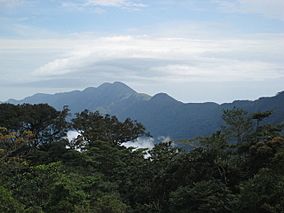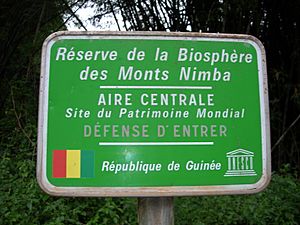Mount Nimba Strict Nature Reserve facts for kids
Quick facts for kids Mount Nimba Strict Nature Reserve |
|
|---|---|
|
IUCN Category Ia (Strict Nature Reserve)
|
|

Mount Nimba landscape
|
|
| Lua error in Module:Location_map at line 420: attempt to index field 'wikibase' (a nil value). | |
| Location | Guinea and Côte d'Ivoire |
| Nearest city | Yekepa, Bossou, N'Zoo |
| Area | 175.4 km2 (43,300 acres) |
| Established | 1944 |
| Type: | Natural |
| Criteria: | ix, x |
| Designated: | 1981 (5th session) |
| Reference #: | 155 |
| Region: | Africa |
| Endangered: | 1992–present |
| Extension: | 1982 |
The Mount Nimba Strict Nature Reserve (also known as Réserve naturelle intégrale du Mont Nimba in French) is a special protected area. It is recognized by UNESCO as a World Heritage Site. This amazing place is found in both Guinea and Côte d'Ivoire.
The reserve covers a total area of about 175.4 square kilometers (or 43,300 acres). Most of it, about 125.4 square kilometers (31,000 acres), is in Guinea. The rest, 50 square kilometers (12,000 acres), is in Côte d'Ivoire.
This reserve protects important parts of the Nimba Range mountains. This area is very unique because it has a huge variety of plants (flora) and animals (fauna). Many species found here live nowhere else in the world. These include special toads called Nimbaphrynoides, the Nimba otter shrew, and several types of horseshoe bats. The highest point in the reserve is Mount Richard-Molard, which stands at 1,752 meters (5,750 feet) tall. It is the highest mountain in both Guinea and Côte d'Ivoire.
Contents
History of the Reserve
The Mount Nimba Strict Nature Reserve was created a long time ago to protect its unique nature. The part in Côte d'Ivoire was made a protected area in 1943. The part in Guinea followed in 1944.
In 1980, the Guinean section was also named a biosphere reserve. This means it's a place where nature is protected, but people can also live and work in a way that helps the environment.
Both parts of the reserve were combined in 1981 (Guinea) and 1982 (Côte d'Ivoire) to form one World Heritage Site. This was done because of its incredible variety of life and special natural habitats.
Since 1992, the reserve has been listed as a World Heritage Site in danger. This is because people started looking for iron-ore to mine in the mountains. To help protect the reserve better, a special center is being built by the Guinean Parks Foundation. The governments of Guinea and CEGENS approved this project in 2016.
Exploring the Geography
The Nimba Range is a long, narrow mountain ridge, stretching about 40 kilometers (25 miles). It runs from northeast to southwest and is part of the Guinea Highlands.
Tallest Peaks in the Nimba Range
The highest peak is Mount Richard-Molard, which is 1,752 meters (5,750 feet) high. Other tall peaks in the Guinean part of the reserve include:
- Grand Rochers at 1,694 meters (5,558 feet)
- Mont Sempéré at 1,682 meters (5,518 feet)
- Mont Piérré Richaud at 1,670 meters (5,479 feet)
- Mont Tô at 1,675 meters (5,495 feet)
- Mont LeClerc at 1,577 meters (5,174 feet)
Rivers and Water Sources
About fifty springs start in the Nimba Range. These springs are the beginnings of important rivers like the Cavally, Cestos, and Sassandra Rivers.
Sadly, mining for iron-ore is a big threat to the unique shape of the mountains and the wildlife that lives there.
Climate of Mount Nimba
The Nimba Range has a special mountain climate that is close to the equator. The temperature changes a lot depending on how high up you are. During the day, it can be between 24°C and 33°C (75°F and 91°F). At night, it can get colder than 10°C (50°F).
Some parts of the reserve get less rain. This happens because of a rain-shadow effect from the tall mountains. The southern slopes are usually wetter. The northern slopes are drier because of the dry Harmattan wind that blows from the Sahara desert. The Nimba Range has many different small climates, which helps many different species live there.
Amazing Ecology and Wildlife
The Mount Nimba Strict Nature Reserve is part of the Guinean Forests of West Africa Biodiversity Hotspot. This means it's one of the most important places in the world for different kinds of life.
Plants of Mount Nimba
The reserve is home to over 2,000 types of vascular plants. These are plants with special tissues to carry water and nutrients.
Animals of Mount Nimba
More than 317 types of vertebrates (animals with backbones) live here. This includes 107 different kinds of mammals. There are also over 2,500 types of invertebrates (animals without backbones). Scientists are still studying the reserve, and they believe there are many more unknown species to discover!
Some animals that live only in this reserve include:
- The Nimba viviparous toad (Nimbaphrynoides occidentalis). This toad is special because it gives birth to live young, instead of laying eggs.
- Lamotte's roundleaf bat (Hipposideros lamottei).
- Nimba otter shrew (Micropotamogale lamottei).
Other rare and endangered animals found here are:
- The West African lion (Panthera leo senegalensis).
- The pygmy hippopotamus (Choeropsis liberiensis).
- The zebra duiker (Cephalophus zebra).
- A group of western chimpanzees (Pan troglodytes verus) that are famous for using stones as tools.
Different Habitats and Forests
The reserve has several different natural areas, called ecoregions. These include:
- Western Guinean lowland forest
- Guinean montane forest
- Guinean forest-savanna mosaic
- West Sudanian savanna
The Nimba Range is also a special freshwater ecoregion. It has many unique water species that are found nowhere else.
The types of plants you see change depending on how high up you are and which direction the slope faces.
- The mountain is surrounded by West Sudanian savanna and Guinean forest-savannah mosaic lowlands. These savanna areas have patches of gallery forests (forests along rivers) and dense forest islands.
- The lower parts of the mountain, up to 600 meters (about 2,000 feet), are covered by Western Guinean Lowland Forest. These are tall, semi-deciduous forests. A single hectare (about 2.5 acres) can have 40-70 different tree species. The whole area has up to 500 different forest tree species.
- Guinean Montane Forests are found between 600 and 1200–1400 meters (about 2,000 to 4,600 feet). At lower levels, these are still semi-deciduous forests, but with fewer species than the lowlands. Higher up, from 900 meters (about 3,000 feet), the mountain is often covered by clouds. Here, you find mossy forests. These include Parinari exclesa forests, summit forests, and tree fern forests in wet valleys.
- Above the tree line, from 1200 to 1400 meters (about 4,000 to 4,600 feet) up to the highest peaks, there are high-altitude grasslands. This is where you can find the famous Nimba viviparous toad and Lamotte's roundleaf bat. Unique plants like Asplenium schnellii, Osbeckia porteresii, and Blaeria nimbana also grow here.
Visiting Mount Nimba
Mount Nimba is in a remote area, right where Guinea, Côte d'Ivoire, and Liberia meet. It's quite far from the capital cities. Sadly, the Liberian part of the mountain has been damaged by past mining.
However, the Guinean side of the mountain is very well protected. This means it still has its natural mountain ecosystems and unique animals and plants. The Ivorian section is also very small but well-preserved.
If you want to visit this amazing strict nature reserve, the best way is from Guinea. A local tour operator can help arrange guided tours from the capital city, Conakry.
Interesting Fact
On November 13, 2013, one of four honey buzzards from Kempen-Broek (a nature area in Europe) flew over this national park. These buzzards had GPS trackers, so scientists could follow their journey!
Gallery
See also
 In Spanish: Reserva natural integral del Monte Nimba para niños
In Spanish: Reserva natural integral del Monte Nimba para niños
- Nimba Range
- Mount Richard-Molard
- Wildlife of Guinea
- Wildlife of Ivory Coast
- Forest Guinea










